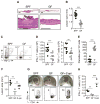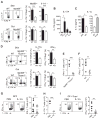Compartmentalized control of skin immunity by resident commensals
- PMID: 22837383
- PMCID: PMC3513834
- DOI: 10.1126/science.1225152
Compartmentalized control of skin immunity by resident commensals
Abstract
Intestinal commensal bacteria induce protective and regulatory responses that maintain host-microbial mutualism. However, the contribution of tissue-resident commensals to immunity and inflammation at other barrier sites has not been addressed. We found that in mice, the skin microbiota have an autonomous role in controlling the local inflammatory milieu and tuning resident T lymphocyte function. Protective immunity to a cutaneous pathogen was found to be critically dependent on the skin microbiota but not the gut microbiota. Furthermore, skin commensals tuned the function of local T cells in a manner dependent on signaling downstream of the interleukin-1 receptor. These findings underscore the importance of the microbiota as a distinctive feature of tissue compartmentalization, and provide insight into mechanisms of immune system regulation by resident commensal niches in health and disease.
Figures




Comment in
-
Immune regulation: Local government.Nat Rev Immunol. 2012 Sep;12(9):615. doi: 10.1038/nri3289. Nat Rev Immunol. 2012. PMID: 22918458 No abstract available.
References
Publication types
MeSH terms
Grants and funding
LinkOut - more resources
Full Text Sources
Other Literature Sources
Molecular Biology Databases

